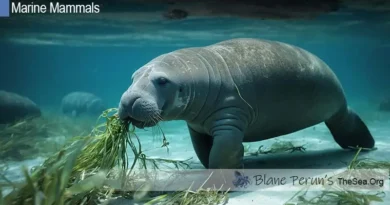West Indian Manatee
Table of Contents
The Gentle Giants of the Sea: West Indian Manatee
Dive into the serene underwater world of the West Indian Manatee (Trichechus manatus), a gentle marine mammal that glides through the warm coastal waters and rivers of the Caribbean Sea and the Gulf of Mexico. Often referred to as “sea cows,” these creatures captivate the hearts of many with their slow, graceful movements and friendly demeanor. Despite their sizeable appearance, manatees lead a peaceful existence, primarily feeding on aquatic plants. This introductory glimpse into their world sets the stage for a deeper exploration of their habitat, behavior, and the unique challenges they face.
Habitat and Migration Patterns
The Coastal Haven
West Indian Manatees thrive in shallow coastal areas, estuaries, and rivers where seagrasses and freshwater vegetation abound. Their habitats are characterized by warm, calm waters, which are crucial for their survival, especially during colder months. These areas provide not only nourishment but also breeding grounds, making them essential for the species’ lifecycle.
Seasonal Travelers
The migration patterns of the West Indian Manatee are closely tied to water temperatures. As mammals, they require warm waters to maintain their body temperature. During winter, they are often found congregating in natural springs or near power plant outflows where the water remains warm, showcasing their adaptability to both natural and altered environments.
Diet and Feeding Habits
Aquatic Grazers
Manatees are herbivores, spending a significant portion of their day feeding on a variety of aquatic plants. This diet plays a crucial role in the ecosystem, as it helps maintain healthy seagrass beds and aquatic vegetation. Their feeding habits are a fascinating aspect of their biology, demonstrating a delicate balance between their needs and the health of their underwater habitats.
The Role of Molars
An interesting feature of the West Indian Manatee is its unique dental adaptation. They possess a set of continuously replaced molars, a trait that allows them to efficiently process a diet consisting mainly of abrasive vegetation. This dental conveyor belt ensures that worn teeth are replaced, highlighting an evolutionary adaptation to their herbivorous lifestyle.
Reproduction and Social Structure
Maternal Bonds
The reproductive behavior of West Indian Manatees is marked by a strong maternal bond. Females, known as cows, give birth to a single calf after a gestation period of about 12 months. The calves are dependent on their mothers for up to two years, during which they learn essential survival skills, including migration routes and feeding areas.
Social Creatures
Despite their seemingly solitary nature, West Indian Manatees are quite social. They engage in group activities, particularly in warm water refuges during the winter. These gatherings are not only crucial for warmth but also provide opportunities for social interaction and mating, revealing a complex social structure beneath their calm exterior.
In conclusion, the West Indian Manatee is a remarkable species that plays a vital role in its ecosystem. Understanding their habits, behaviors, and challenges is essential for their conservation and the health of marine environments. As we continue to explore and protect these gentle giants, we uncover the intricate balance of nature and the importance of every creature within it.
FAQs about West Indian Manatee
What do West Indian Manatees eat?
West Indian Manatees are herbivores, primarily feeding on a wide variety of aquatic plants, including seagrasses and freshwater vegetation. Their diet is crucial for the maintenance of healthy aquatic ecosystems, as it helps control the growth of vegetation.
How do West Indian Manatees reproduce?
The reproduction process of West Indian Manatees involves a lengthy gestation period of about 12 months, after which the female gives birth to a single calf. These calves remain with their mothers for up to two years, learning vital survival skills.
What is the lifespan of a West Indian Manatee?
West Indian Manatees can live up to 40 years or more in the wild, although their lifespan is often shortened by human-related threats and natural predators. Their longevity is a testament to their resilience and the importance of conservation efforts.
Are West Indian Manatees endangered?
Yes, West Indian Manatees are considered vulnerable due to a variety of human-related threats, including habitat loss, boat strikes, and pollution. Conservation efforts are crucial to ensure their survival and the protection of their natural habitats.
How do West Indian Manatees maintain their body temperature?
West Indian Manatees maintain their body temperature by migrating to warmer waters during colder months. They are often found in natural springs or near power plant outflows, where the water remains consistently warm, providing a refuge from colder temperatures.




